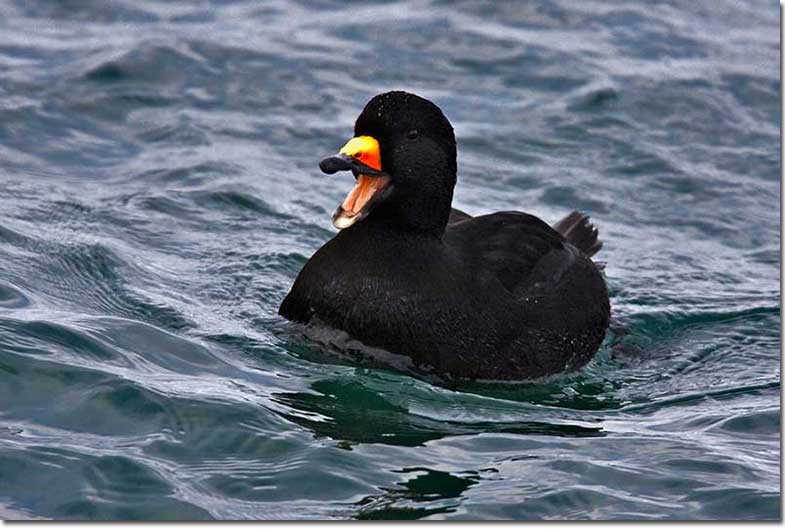
Duck species are common birds in many parts of the USA including the state of Maine. Go birding in Maine and you can see lots of ducks! Several species live in coastal waters and wetlands throughout the state.
How many ducks have you seen in Maine? We bet you’ve seen a lot, but how many could you identify?
Maine’s Duck Population
It shouldn’t come as a surprise, but Maine is a true duck state. In total, there are more than 30 species ever spotted, but to keep it simple, we focused on 15 most common duck species.
As always, our data comes from eBird; their data is based on sightings.
Mallard
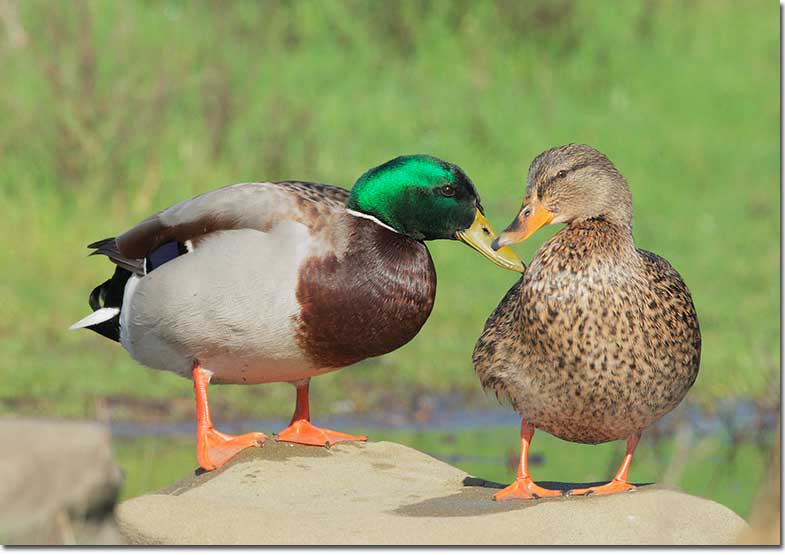
Scientific name: Anas platyrhynchos
Length: 23 inches
Wingspan: 35 inches
Mallards are the most familiar duck species. For lots of folks, this is “the duck”. They have been domesticated for centuries and lots of them are fed at urban ponds and lakes.
However, make no doubt about it, Mallards are wild birds that also live in lots of wild and remote areas in most of North America. The males have a dark green head, narrow white collar, yellowish beak, and dark brown chest.
Female Mallards, though, can be trickier to identify. They are brown with some paler brown and dark markings, and have a gray-brown neck and head with a dark cap, and a dark line through their eyes.
In flight, we can also recognize female Mallards by their pale tail, and two white wing bards bordering a green-blue wing patch.
In addition to eating bird food and vegetables, Mallards dabble in shallow water for plant matter and small creatures.
Key identifications:
- Big duck with a glossy green head and yellowish beak.
- The female has a dark center mark on her orange beak.
- Short, pale, or white tail.
Common Eider
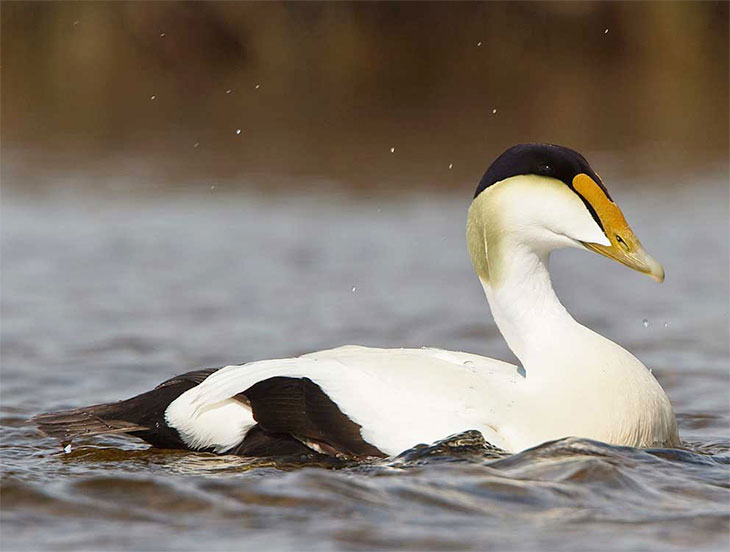
Photograph © Glenn Bartley
Scientific name: Somateria mollissima
Length: 24 inches
Wingspan: 38 inches
Common Eiders are big, hefty ducks with an odd, wedge-shaped head. Drakes have striking white plumage with black on their belly, tail, head, and wings. They also have pale green on the back of their neck and a yellowish or greenish beak.
Female Common Eiders are mottled gray-brown, and winter and juvenile males are mostly black with some bits of white.
These large ducks nest in cold, northern coastal habitats, even as far north as Alaska and northern Canada! In winter, flocks forage for mollusks and other small sea creatures in cold coastal waters in Alaska, British Columbia, and eastern Canada south to New Jersey.
Most birders see this bird in winter as they flock near rocky northern shores. Eider down keeps these hardy ducks warm in their cold aquatic habitats. For centuries, people have gathered those same special feathers from Common Eider nests to insulate jackets, pillows, and quilts.
Key identifications:
- Big duck with an elongated wedge-shaped head.
- Breeding males are black and white with a black cap.
- Females are mottled gray brown with fine dark barring on their sides.
American Black Duck
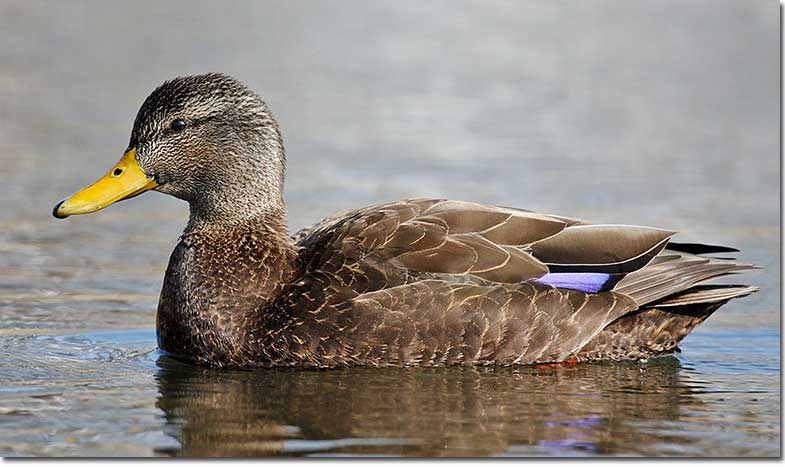
Scientific name: Anas rubripes
Length: 23 inches
Wingspan: 35 inches
American Black Ducks are big and hefty ducks with dark brown bodies. In certain lighting conditions, true to their name, they can look blackish.
They also have a pale, brown-grayish neck and head with a small dark cap and a dark line through their eyes. Males are more uniformly dark than females while hen American Black Ducks show some buff edging on their feathers.
In flight, their white underwings contrast with their dark upperwings. You might also notice the dark blue patch on the base of their upperwing.
This species usually occurs in pairs or small groups that dabble for plant matter and small creatures in shallow wetlands. They don’t form flocks as big as many other duck species.
American Black Ducks breed in shallow marshes and other wetlands in eastern Canada and the northeastern USA. For the winter, they migrate to lakes and other wetlands in the eastern USA.
Key identifications:
- Dark body with a pale head.
- Dingy greenish yellow beak.
- Mostly dark upperwings and white underwings.
Bufflehead
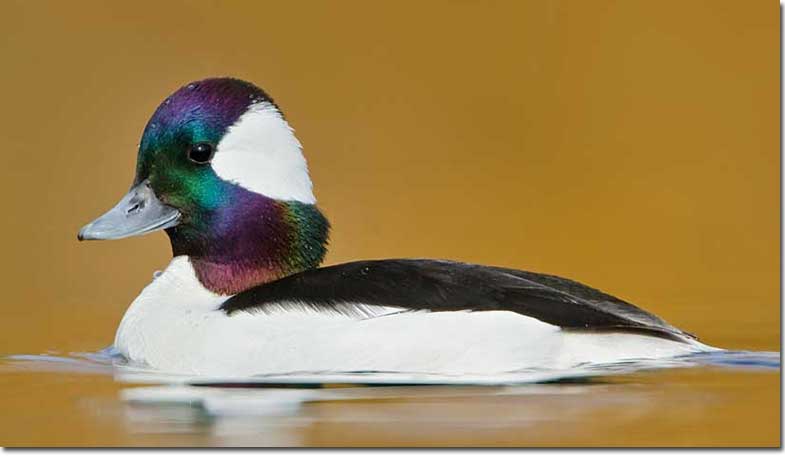
Scientific name: Bucephala albeola
Length: 13.5 inches
Wingspan: 21 inches
Buffleheads are small, cute ducks with rounded heads and stout little beaks. Males are bold, black and white birds with a big white patch on their head. In good light, their head also has green and purple iridescence.
Female Buffleheads are more gray-brown with a white belly, and have a smaller white head patch.
During their fast flight, Buffleheads show a white patch in their wings although the female’s white patch is smaller. These ducks breed on northern, forested lakes in Alaska, Canada, and parts of the northwestern USA.
Like some other small ducks, they need tree cavities for nesting and often use holes made by Northern Flickers.
For the winter, they migrate to coastal waters and lakes, big rivers, and reservoirs in parts of southern Canada and most of the USA.
Buffleheads dive to forage for mollusks and other small creatures. They also occur in flocks, sometimes with goldeneyes and other diving birds, especially in winter.
Key identifications:
- Small chunky duck with stout gray beak.
- Rounded head with a bold white patch.
- Mostly black and white or grayish with a white belly and small white wing patch.
Long-tailed Duck
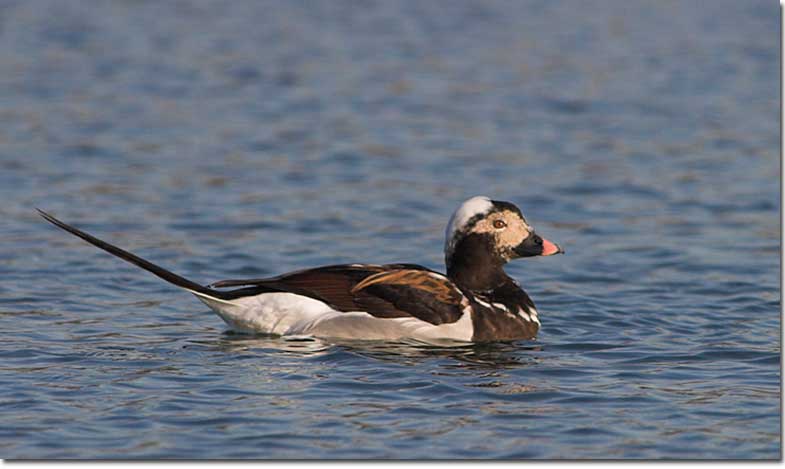
Scientific name: Clangula hyemalis
Length: 16.5 inches
Wingspan: 28 inches
Long-tailed Ducks are small pale ducks at home on cold, Arctic tundra lakes. Breeding males have smart-looking, black plumage with a pale gray face patch, white belly and sides, and some brown feathers on their back.
They also have long, black central tail feathers! However, since they live so far north, not a whole lot of people get to see them in their breeding plumage. Most male Long-tailed Ducks that birders see have much more white on their head, neck, and chest, and silvery feathers on their backs.
Females don’t look as exotic and lack the male’s long tail feathers but are still nice to see! They are gray-brown with white on their head, belly, and undertail.
Both sexes have fairly broad black wings and forage for small aquatic animals by diving underwater. These small ducks breed on ponds and other wetlands but flocks winter in coastal waters on both coasts and some large lakes.
Key identifications:
- White belly, dark chest, and broad, black wings.
- Small beak, and gray and white plumage with some black markings.
- Pointed tail (very long in male).
Hooded Merganser
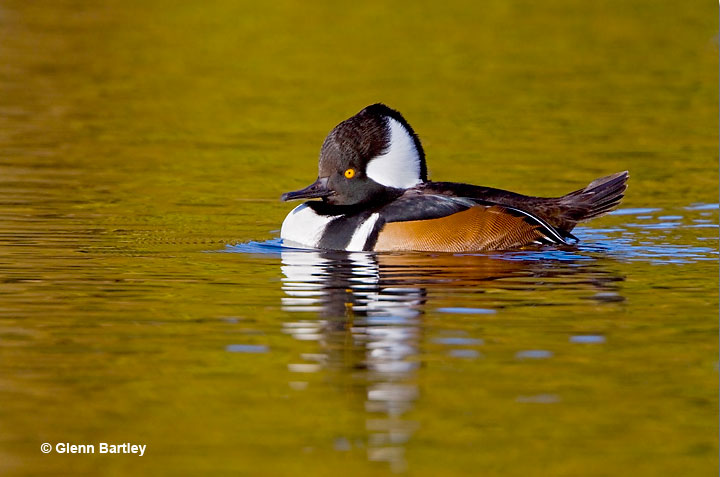
Scientific name: Lophodytes cucullatus
Length: 18 inches
Wingspan: 24 inches
The Hooded Merganser is one of the prettiest little ducks in North America. Breeding males are handsome ducks with a rounded black and white head, and black neck and back. Their jet black upperparts combine nicely with two black marks on a white chest, and rich, pumpkin-colored flanks.
Females aren’t as colorful but are still pretty in their own way. These brown-gray birds have a slender, yellowish beak, and a deep, caramel-colored, rounded crest.
Both sexes also have a longish, somewhat pointed tail, and small white markings on the base of their slender dark wings.
Hooded Mergansers dive for crayfish, small fish, and other small creatures in wooded swamps and marshes. We don’t see them flock together as much as other ducks do, and they usually occur as pairs.
They mostly breed in forests of southern and western Canada, and the northeastern USA, and winter in wooded wetlands along the Pacific coast and in the eastern USA.
Key identifications:
- Small duck with a small, slender beak.
- Blocky or rounded head.
- White belly and a bit of white on the base of narrow wings.
Surf Scoter
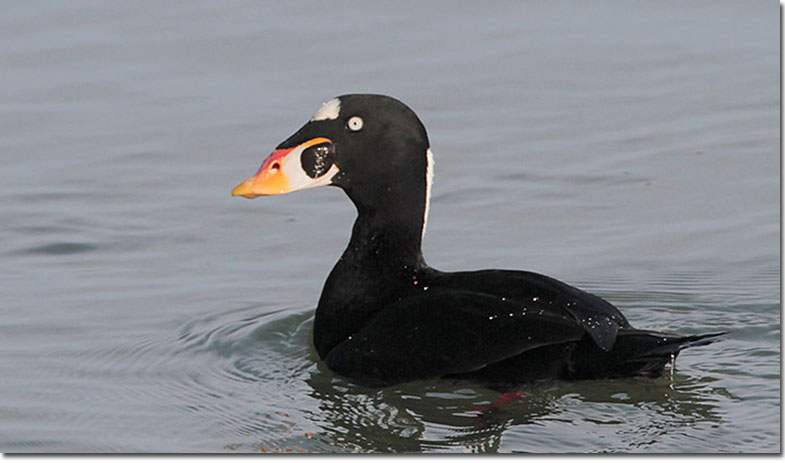
Scientific name: Melanitta perspicillata
Length: 20 inches
Wingspan: 30 inches
Surf Scoters are hefty, jet-black ducks with a big swollen beaks, especially the males. Their large beaks are white, orange, and red, and have a big round black spot!
The male’s other main field marks are a small white patch on the front part of the crown and a big white patch on the back of the neck.
Both sexes of the Surf Scoter also have staring white eyes! However, female Surf Scoters aren’t as fancy. They are dark gray-brown, have a dark cap, and some pale marks on their head.
Young birds have more pronounced white patches on their head, and an extensive whitish belly.
Surf Scoters fly fast, low over the water, and have all-dark wings. They dive for mollusks and other small creatures in cold, northern lakes and coastal waters.
In summer, this species lives in Alaska and parts of northern Canada, and flocks winter on large lakes and along both coasts.
Key identifications:
- A beak with a swollen appearance.
- Dark wings in flight.
- White line at the base of the bill.
Wood Duck
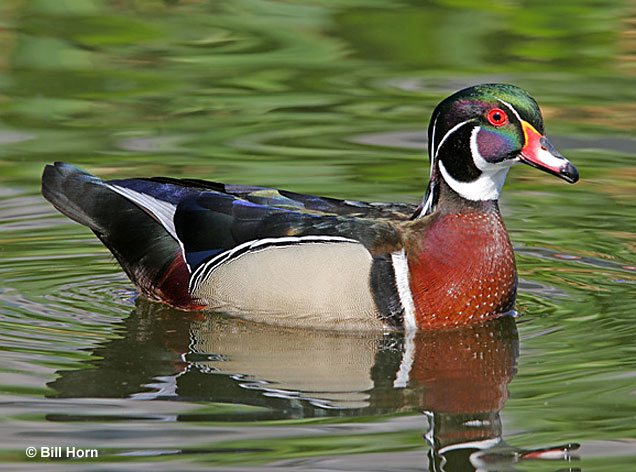
Scientific name: Aix sponsa
Length: 18.5 inches
Wingspan: 30 inches
Wood Ducks are seriously ornamental birds. The males can seem so exotic, it might be hard to believe they are a wild, native species! However, Wood Ducks are indeed native and fairly common in many parts of southern Canada and the USA.
These cute, slender, long-tailed ducks prefer wooded swamps and other wetlands in forested habitats. The males have a rounded head with a dark green crest, black and white face, short red beak, and jade green back. They also have bright buff flanks and a chestnut chest and undertail.
Female Wood Ducks grayish-brown birds that aren’t nearly as fancy but can still be recognized by their blocky head, white spectacles, slender shape, and mostly dark wings.
Wood Ducks usually occur in pairs but can also form small flocks that forage for acorns, plant matter, and small creatures in and near water. We often hear these ducks give their odd, squealing whistle vocalization before we see them.
Key identifications:
- Slender duck with a longish tail and a blocky head.
- Ornate plumage a short, reddish beak.
- Dark wings with a narrow white line on the base of the trailing edge.
Black Scoter
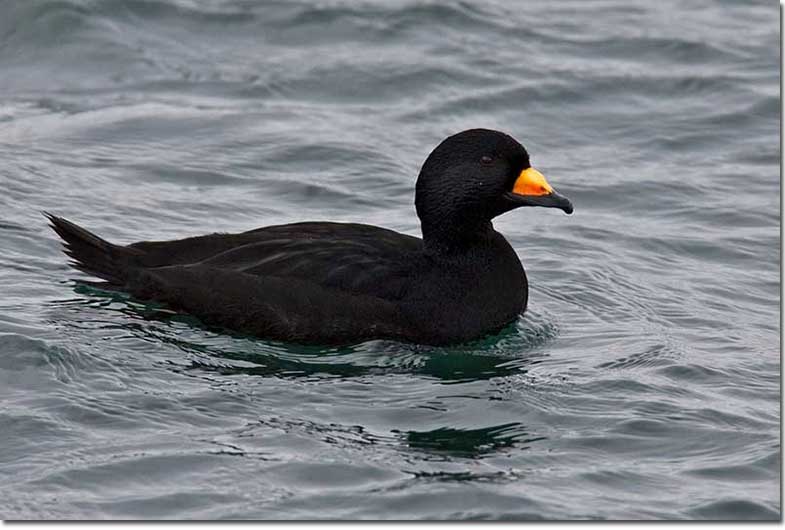
Scientific name: Melanitta americana
Length: 19 inches
Wingspan: 28 inches
Black Scoters are large, all black ducks with fairly large beaks. Males are entirely plush black but also have a big yellow knob on their bill. In flight, they also show slightly paler flight feathers that contrast with the rest of their darker wings.
Female Black Scoters don’t have any yellow on their beaks and look much duller. These birds are dark gray-brown with a blackish cap, and a pale face.
Black Scoters dive for mollusks and other small aquatic creatures in big lakes and coastal waters. In summer, pairs breed on fairly shallow lakes in Alaska and parts of northern Canada. In fall, flocks migrate to inshore waters on both coasts.
A number of Black Scoters migrate through the Great Lakes and can also make stops on large reservoirs. Some also winter on those large interior lakes but most Black Scoter flocks migrate to the coast.
Key identifications:
- Heavy black duck with yellow on its beak (males).
- Dark duck with a dark cap and a pale face (females).
- All dark wings in flight.
Green-winged Teal
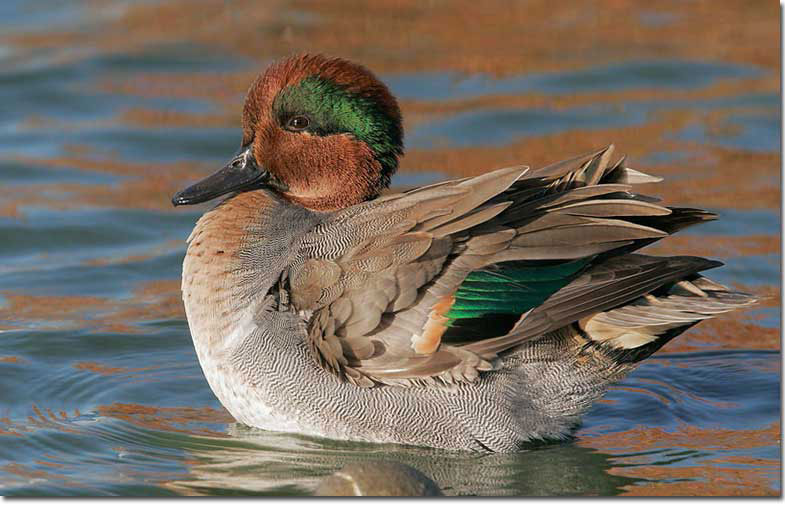
Scientific name: Anas crecca
Length: 14 inches
Wingspan: 23 inches
Green-winged Teals are small waterfowl with a smallish, dark beak, and a dark green patch at the base of each wing. Males of these cute little ducks are mostly gray and have a chestnut head with a dark green patch, speckled, buff chest, and narrow white bar near their chest.
Females are mostly mottled brown with a dark line through each eye. Both sexes have a buff mark on the edge of their tail, and show a white belly in flight. Green-winged Teal like to forage for plants and small creatures in the shallow water of marshes and other wetland habitats.
They breed in Alaska, Canada, and the northern USA, and winter in a variety of wetland habitats in some parts of southern Canada, and most of the USA.
Although this small duck species can form flocks, we often see them in pairs or only in small groups. They also migrate north later than other duck species.
Key identifications:
- Very small duck.
- Buffy mark along the edge of each side of its tail.
- Small dark beak and dark green patch edged with buff on its wings.
Ring-necked Duck
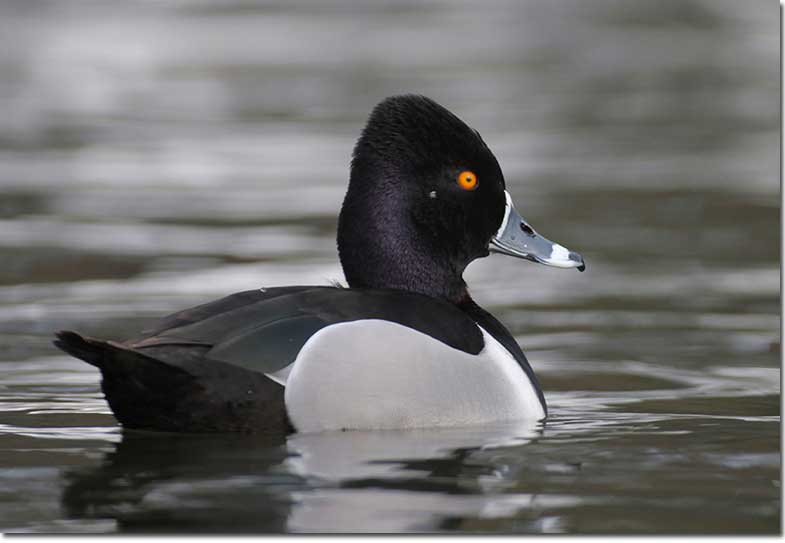
Scientific name: Aythya collaris
Length: 17 inches
Wingspan: 25 inches
Ring-necked Ducks are one of those birds that don’t have the best of names. While males do have a brown ring on their necks, it blends in with their black neck and can be really hard to see.
Ring-necked Ducks should really be called, “Ring-billed Ducks”! The males are best recognized by the white ring near the black tip of their dark gray beak, and their combination of a black back, head, neck, and chest. They also have gray sides and a white mark near their black chest.
Female Ring-necked Ducks are plain, brownish birds with pale bellies and narrow white spectacles on a grayish face. They also show a bit of white on their face, near the base of their bill.
Ring-necked Ducks dabble and make shallow dives for a variety of food items. They like to eat plant matter, insects, and other small aquatic creatures. We find them in a variety of shallow wetlands in much of North America.
Key identifications:
- Male has black back, head, and chest.
- Gray sides with white near the black chest.
- Female has narrow white spectacles on gray face.
Harlequin Duck
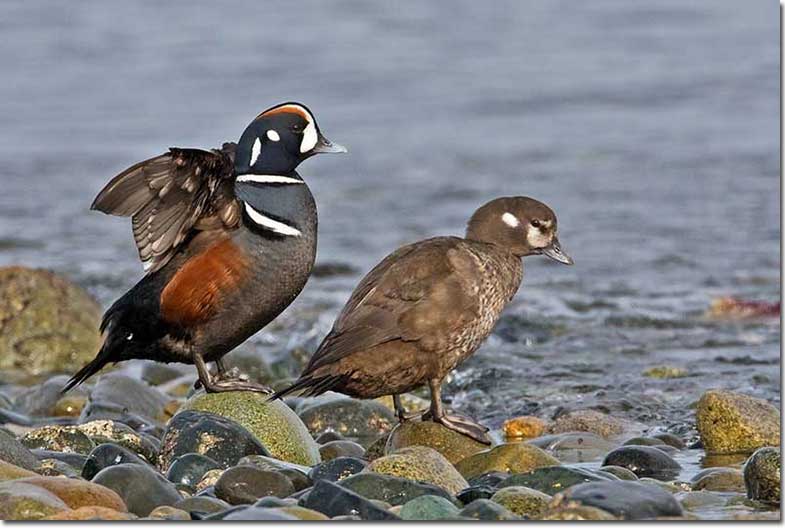
Scientific name: Histrionicus histrionicus
Length: 16.5 inches
Wingspan: 26 inches
Harlequin Ducks are small, unique ducks with small grayish beaks, and longish, pointed tails. Male Harlequins have ornamental plumage that resembles no other bird!
They are dark slaty gray with round and crescent-shaped white marks on their head and sides of their neck and chest. They also have some white marks where their wings meet their body, a bit of red-brown on their head, and red-brown sides.
Female Harlequins aren’t nearly as decorated. These dark brown ducks have a white belly, pale patch in front of their eyes, and a small round white spot on the side of their head.
These cute little ducks show all dark wings in flight, and forage for small aquatic creatures in cold, fast moving water. In summer, Harlequin Ducks breed along rivers in Alaska and western Canada south to Idaho, and in eastern Canada.
In winter, small flocks occur in similar fast water and coastal areas with rough surf conditions.
Key identifications:
- Dark gray with odd white patches.
- Dark brown with a round white spot on the side of the head (females).
- All dark wings in flight.
Ruddy Duck
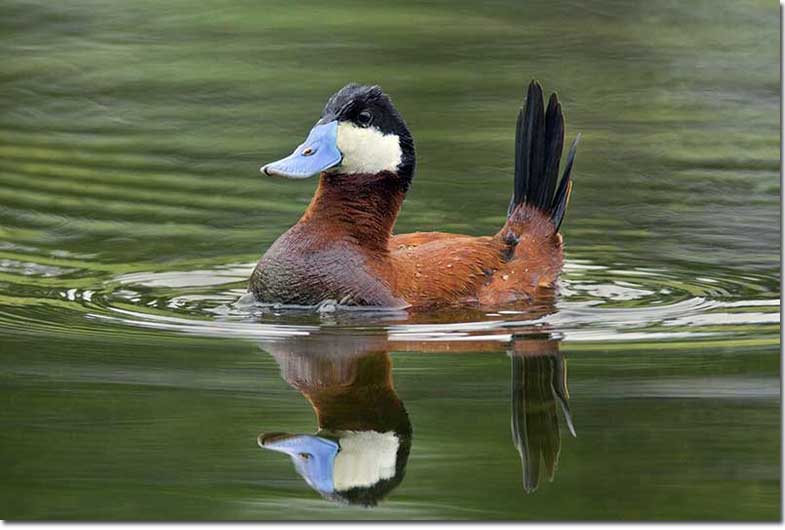
Scientific name: Oxyura jamaicensis
Length: 15 inches
Wingspan: 18.5 inches
Ruddy Ducks are small diving ducks with a unique, big-headed look, and a stiff tail that they often hold upright. Breeding males are a beautiful chestnut bird with a black cap, and a white throat and cheeks. They also have a big and pretty, blue beak that contrasts with the other colors on their head.
Female Ruddy Ducks are grayish birds with darker, more uniform upperparts, and a thick black line on their pale face. They have a duller, darker, more grayish beak than the male. In flight, Ruddy Ducks have mostly dark, rather short and narrow wings.
Ruddy Ducks dive underwater to forage for small aquatic creatures.
This small duck species breeds in shallow marshes and lakes in many parts of central and western North America. They migrate to eastern Canada and the USA and winter on lakes, in coastal waters, and other wetlands in the western and southern USA.
Key identifications:
- Small duck with big bluish beak and a dark cap.
- White cheeks or a dark line on pale cheeks.
- Longish, stiff tail often held upright.
American Wigeon
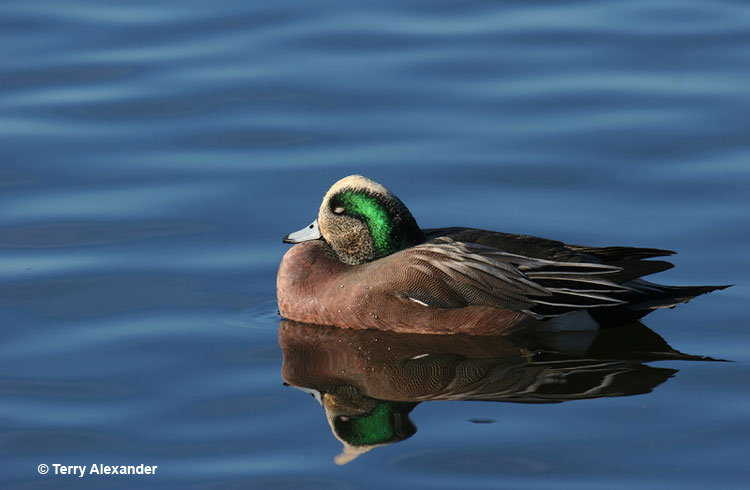
Scientific name: Mareca americana
Length: 20 inches
Wingspan: 32 inches
American Wigeons are medium-sized ducks with a smallish gray beak. Males are gray with a white crown, some dark green near their eyes, and peach-brown colors on their chest and sides.
They also have a black undertail and show white shoulders in flights. Females look like males but lack white and green on their heads and are a bit duller in general. Both sexes have pointed tails and a white belly especially visible in flight.
American Wigeons like to graze grass and eat grain while walking at the edge of wetlands and in wet fields. They can also pick plant matter and small creatures from the surface of the water and even steal food from other ducks!
This waterfowl species breeds in cold, shallow marshes in Alaska, Canada, and parts of the northern USA. They migrate through much of the USA and winter in coastal waters, and on lakes and other wetlands in southern states.
Key identifications:
- Rather small pale gray beak.
- Peach or gray-orange chest and flanks.
- Male has a white crown and white shoulders, female has grayish head with a dark area around her eyes.
Northern Pintail
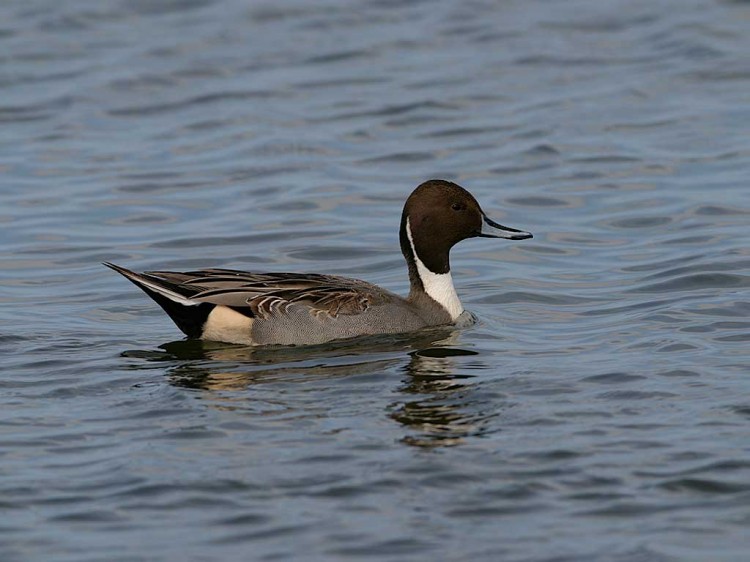
Photograph © Sam Crowe.
Scientific name: Anas acuta
Length: 21 inches
Wingspan: 34 inches
Northern Pintails are fairly large and slender, gray and creamy white ducks with long necks, and long tails. Breeding males are handsome birds with dark, chocolate-brown on their head and neck, a black undertail, and a long pointed tail feather.
Females and nonbreeding males are gray and tawny birds with a plain, pale tawny head and neck, and a gray beak. In flight, Northern Pintails also show long, pale gray wings, and the males have a dark green patch on the base of each wing.
We see these neat ducks in shallow marshes, and on lakes and other wetlands. They often form small groups that can flock with other waterfowl species.
They forage for grains and small aquatic creatures by dabbling in very shallow water and picking food from the wet ground while walking at the edge of the water, and in wet fields.
We see these pretty ducks in shallow wetland habitats in most of North America.
Key identifications:
- Fairly large duck with a long, slender neck.
- Pointed tail.
- Dark brown or tawny head and a gray beak.
Frequently Asked Questions
What is the most common duck species in Maine?
The most common duck species in Maine is the Mallard. According to eBird, Mallards are seen more than any other duck in the state.
How many duck species does Maine have?
Maine has 34 duck species! However, seven of those duck species are rare visitors to the state.
Do ducks migrate from Maine?
Yes, several ducks migrate to and from Maine.
More in Maine: Most common birds | Hawks | Owls | State bird

